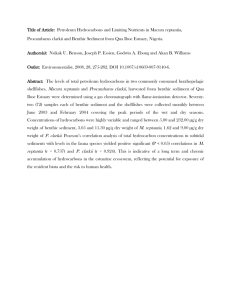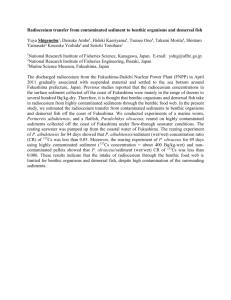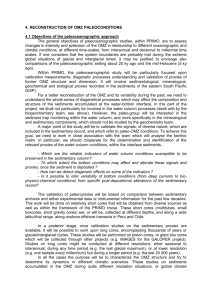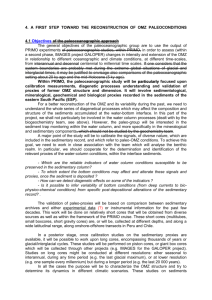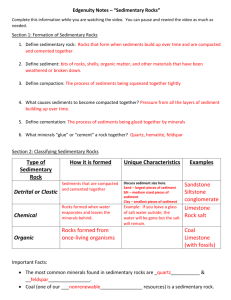Biogeobenthic
advertisement
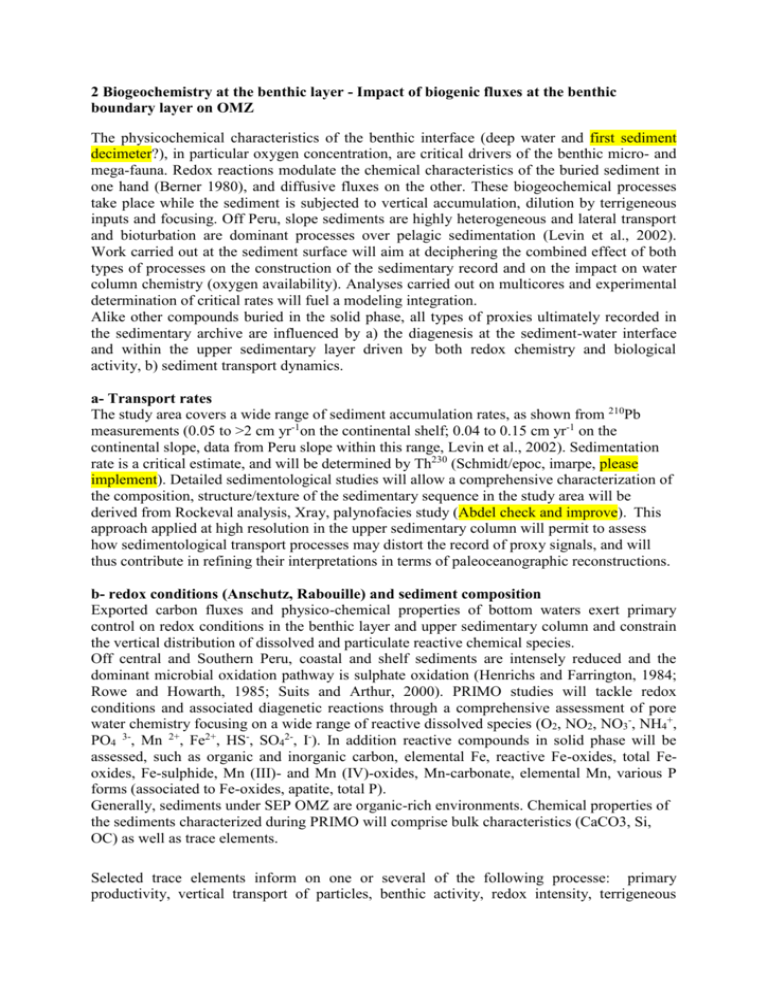
2 Biogeochemistry at the benthic layer - Impact of biogenic fluxes at the benthic boundary layer on OMZ The physicochemical characteristics of the benthic interface (deep water and first sediment decimeter?), in particular oxygen concentration, are critical drivers of the benthic micro- and mega-fauna. Redox reactions modulate the chemical characteristics of the buried sediment in one hand (Berner 1980), and diffusive fluxes on the other. These biogeochemical processes take place while the sediment is subjected to vertical accumulation, dilution by terrigeneous inputs and focusing. Off Peru, slope sediments are highly heterogeneous and lateral transport and bioturbation are dominant processes over pelagic sedimentation (Levin et al., 2002). Work carried out at the sediment surface will aim at deciphering the combined effect of both types of processes on the construction of the sedimentary record and on the impact on water column chemistry (oxygen availability). Analyses carried out on multicores and experimental determination of critical rates will fuel a modeling integration. Alike other compounds buried in the solid phase, all types of proxies ultimately recorded in the sedimentary archive are influenced by a) the diagenesis at the sediment-water interface and within the upper sedimentary layer driven by both redox chemistry and biological activity, b) sediment transport dynamics. a- Transport rates The study area covers a wide range of sediment accumulation rates, as shown from 210Pb measurements (0.05 to >2 cm yr-1on the continental shelf; 0.04 to 0.15 cm yr-1 on the continental slope, data from Peru slope within this range, Levin et al., 2002). Sedimentation rate is a critical estimate, and will be determined by Th230 (Schmidt/epoc, imarpe, please implement). Detailed sedimentological studies will allow a comprehensive characterization of the composition, structure/texture of the sedimentary sequence in the study area will be derived from Rockeval analysis, Xray, palynofacies study (Abdel check and improve). This approach applied at high resolution in the upper sedimentary column will permit to assess how sedimentological transport processes may distort the record of proxy signals, and will thus contribute in refining their interpretations in terms of paleoceanographic reconstructions. b- redox conditions (Anschutz, Rabouille) and sediment composition Exported carbon fluxes and physico-chemical properties of bottom waters exert primary control on redox conditions in the benthic layer and upper sedimentary column and constrain the vertical distribution of dissolved and particulate reactive chemical species. Off central and Southern Peru, coastal and shelf sediments are intensely reduced and the dominant microbial oxidation pathway is sulphate oxidation (Henrichs and Farrington, 1984; Rowe and Howarth, 1985; Suits and Arthur, 2000). PRIMO studies will tackle redox conditions and associated diagenetic reactions through a comprehensive assessment of pore water chemistry focusing on a wide range of reactive dissolved species (O2, NO2, NO3-, NH4+, PO4 3-, Mn 2+, Fe2+, HS-, SO42-, I-). In addition reactive compounds in solid phase will be assessed, such as organic and inorganic carbon, elemental Fe, reactive Fe-oxides, total Feoxides, Fe-sulphide, Mn (III)- and Mn (IV)-oxides, Mn-carbonate, elemental Mn, various P forms (associated to Fe-oxides, apatite, total P). Generally, sediments under SEP OMZ are organic-rich environments. Chemical properties of the sediments characterized during PRIMO will comprise bulk characteristics (CaCO3, Si, OC) as well as trace elements. Selected trace elements inform on one or several of the following processe: primary productivity, vertical transport of particles, benthic activity, redox intensity, terrigeneous inputs, denitrifiacation, sulfatoreduction,… etc. Quantification of associated fluxes in a well constrain situation will provide a pertinent data set to better understand the mode of formation and of burial of the information borne by these elements and by combining various elements. Bearing together these information, those from benthic communities and those from redox conditions will allow to constrain the impact of environmental conditions on the buried sediment characteristics. This approach is particularly relevant to the improvement of proxies. For instance the pattern of accumulation of redox-sensitive metals (U, Mo, Re, Ag, some Rare Earth Elements?) in marine sediments is thought to reflect oceanic productivity represented by a flux of organic matter to the seafloor. The distribution of these metals in marine sediments can be used to determine bottom water redox conditions at the time of deposition. Other selected elements are biomarkers. NB: at this location, I cannot introduce the species (nannofossils, diatoms, etc) because there are in the paragraph b. However it would be logical to have them associated. Your opinion? Abdel and others, do I say too much/ too little about proxies here? Comprehensive understanding of early diagenetic redox processes is a requisite to implement proxies understanding, since these processes transform proxies derived from the water column or are at the origin and subsequent modification of authigenic proxy-signals. Experimental work in controlled conditions will allow the determination of critical parameters for modeling, for instance BSi dissolution rate respectively to organic carbon decay. (Olivier, Christophe, Ioanna, Vincent: Should we detail more the experiments after your meeting on the 14th of April? Please implement). ¿Measurements of co2 production, sulphite production, elements implied in the N cycle? ¿S cycle, S-biomarkers locean ? S cycle histo, laminated sediment, Xray microscopy epoc, paleot? c Benthic community structure; micro-, meio- and macro-benthos (Guiterrez Graco, imarpe stora lmgem benthic foram’s Angers ?) Benthic biota affects both sediment properties (e.g., biomixing) and distribution of chemical species, and among them proxies, through the metabolism of the sedimentary fauna. Structure and functioning of eukaryotic and prokaryotic benthic communities and their response and feedback to changing oceanographic/biogeochemical conditions are key issues addressed within PRIMO. Oxygen availability, flux of organic matter to the sediment, benthic communities and bioturbation show complex interactions (Gutierrez et al., 2000, Lvin et al.,2002). Living species that may become fossil proxies do not escape this rule (Jorissen et al., 1996; Fontanier et al., 2002). The inner shelf of the study area is oxygenated all year around. At the outer shelf-upper slope, the OMZ impinges the sediments during ENSO years. Meiofauna, mainly calcareous foraminifera and nematodes are the organisms most tolerant of nearly anoxic, organic-rich conditions (Levin et al., 2002). Very low oxygen conditions see the development of giant prokaryotes, principally sulfide oxidizer, but also nitrate reducers and chemosynthetic bacteria (Jorgensen et Gallardo, 1999; Otte et al., 2000; Graco, 2002). Our present knowledge does not allow to comprehend the role of benthic communities on fluxes of elements and on the construction of the sediment. PRIMO will address the ecological and biogeochemical roles of the prokaryotic and faunal assemblages on anaerobic respirations by a process study, stressing denitrification processes. Coupling between benthic processes studies and proxy measurements will allow comprehending how proxies are altered through biotic and abiotic processes at the sedimentwater interface and during early burial (upper sedimentary layer). Biomarkers will be used to infer the contribution of algal detritus fuelled by vertical transport of particles, of their decay and transformation; biomarkers of the benthic microfauna will also be determined.
